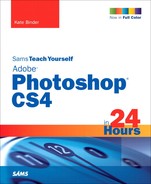Photoshop CS4 is a big program—really, really big. It can do a lot of cool things. In fact, it has so many neat tricks that Adobe decided that the best way to wrangle all those features was to release two different versions: Photoshop CS4 Standard and Photoshop CS4 Extended. The Standard program is Photoshop as we know and love it, and that’s what we’ve talked about for the last 24 hours. But there’s more to love, and that’s what Photoshop Extended is all about. Here’s a look at what you’ll get if you decide to shell out the extra bucks and go Extended.
Among its hot new features, Photoshop Extended includes tools targeted at 3D designers and videographers.
In the 3D realm, Photoshop Extended lets you open 3D model files; move, rotate, and scale them; edit their textures; and even paint directly onto them. Three-dimensional objects live on special layers called 3D layers, and you can combine these with regular image layers to give your 3D objects backgrounds. You can even create new 3D layers in Photoshop CS4 Extended, starting from an existing layer, and you can now work with individual objects on a 3D layer.
For video hotshots, the Extended version’s Animation panel has a special Timeline mode that offers a visual representation of the time each frame takes up within the video sequence. And once you’ve created an animation, you can export it directly to AVI, MPEG-4, or Flash Video (FLV) format by choosing File, Export, Render Video. You can also import and export image sequences in Photoshop, BMP, Cineon, JPEG, JPEG 2000, OpenEXR, PNG, Targa, and TIFF formats. And Extended has special video layers and clone options for video frames.
Photoshop’s Ruler tool—now renamed the Measure tool—has been around for quite a while, and it enables you to measure distances within an image. But knowing that your cat’s eyes are 47 pixels wide in a particular image isn’t all that useful in the real world. So Photoshop Extended enables you to attach a real-world scale to measurements within an image. You can use the Set Scale command to tell Photoshop the real-world equivalent of a distance within an image, and Photoshop can then turn around and translate all your measurements within that image into real-world terms.
Extended also features a Count tool: Just click on each object to add to your running tally. Even more useful, Photoshop can store counts and measurements and export that data so that you can use it in spreadsheets. Who would use this feature? Medical researchers might count bacteria on a microscope image, and livestock managers might count cows on a satellite image. The possibilities are ... interesting.
Speaking of medical researchers, Photoshop Extended supports the DICOM medical imaging format. These are the images you get from a CAT scan, MRI, ultrasound, or x-ray, and often a DICOM file contains multiple images. Photoshop enables you to choose how to view multi-image files: with each image on a separate layer or lined up in a grid format. You can use all Photoshop’s tools to enhance and mark up DICOM images.
Many scientists use a program called MATLAB for complicated mathematical computations, many of which involve graphical representations of complex concepts. Photoshop Extended can now make these people’s jobs easier by working with MATLAB. Using add-ons that come with Photoshop Extended, MATLAB users can control Photoshop from MATLAB’s command-line interface, and they can combine MATLAB’s graphics tools with Photoshop’s image-processing expertise for a truly powerful package.
